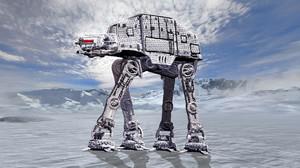RoboticsAgile scouting robots
Researchers have developed an agile robot, called Salto, that looks like a Star Wars Imperial walker in miniature and may be able to aid in scouting and search-and-rescue operations. Robots like this may one day be used to save lives of both warfighters and civilians, researchers said.

Fantasy inspires reality // Source: flickr.com
In a research project for the U.S. Army, researchers at the University of California, Berkeley developed an agile robot, called Salto, that looks like a Star Wars Imperial walker in miniature and may be able to aid in scouting and search-and-rescue operations. Robots like this may one day be used to save lives of both warfighters and civilians, researchers said.
Topping out at less than a foot, Salto, which stands for saltatorial (leaping like a grasshopper) locomotion on terrain obstacles, now has a sophisticated control systems that allows it to master increasingly complex tasks, like bouncing in place, navigating an obstacle course or following a moving target, all controlled with a radio controller.
ARL says that in 2016, the research team demonstrated how Salto could take a leap and then immediately spring higher by ricocheting off a wall, making it the world’s most vertically agile robot—jumping for than three times its height.
With its new capabilities, the researchers hope Salto will propel the development of small, nimble robots that could leap through rubble to aid in search-and-rescue and other military missions.
“The physical environment the Army operates in is highly irregular, cluttered, and constantly changing,” said Dr. Samuel Stanton, program manager at Army Research Office, an element of U.S. Army Combat Capability Development Command’s Army Research Laboratory. “The science underlying the advancements is critical for achieving the desired mobility, speed of action, and situational awareness generation necessary for future Army operations.”
The research team described the robot’s new skills at the 2019 International Conference on Robotics and Automation in Montreal 21 May.
“Small robots are really great for a lot of things, like running around in places where larger robots or humans can’t fit. For example, in a disaster scenario, where people might be trapped under rubble, robots might be really useful at finding the people in a way that is not dangerous to rescuers and might even be faster than rescuers could have done unaided,” said UC Berkeley robotics graduate student
